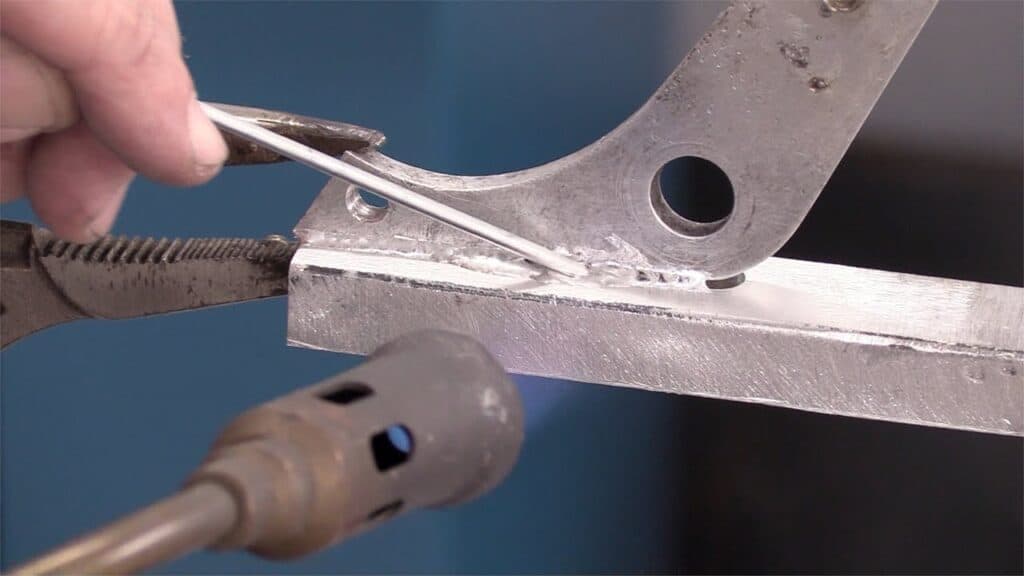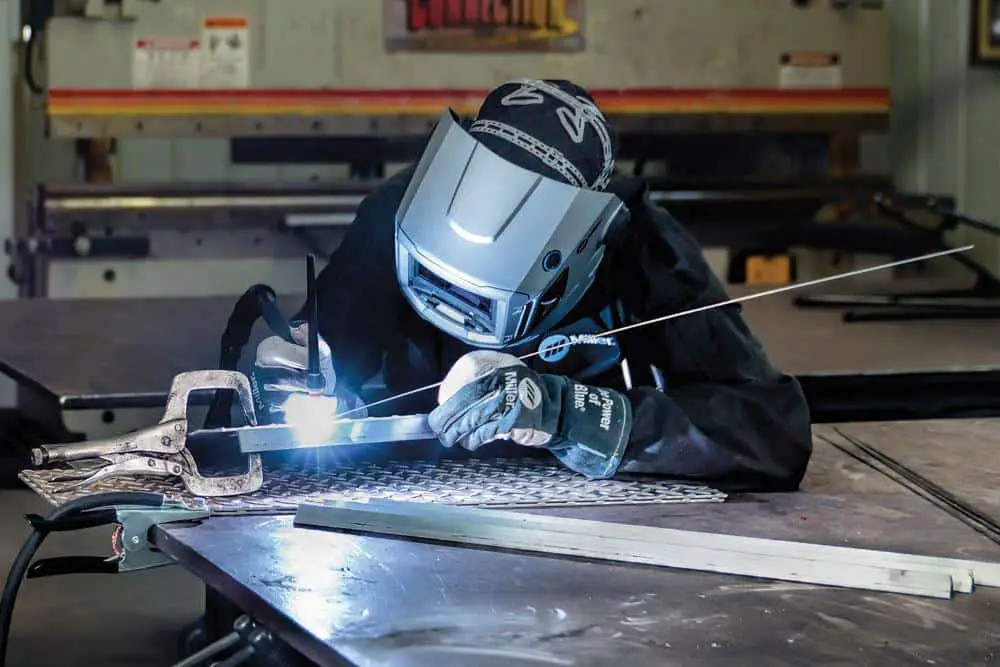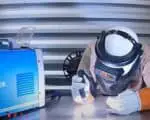Welding aluminium is not that easy as welding steel. This is because aluminium is a soft metal and melts quite easily. Also, you need to remove the oxide layer from the aluminium first before starting with the welding process as the oxide burns at higher temperature than the aluminium itself.
 Therefore, you need to be very careful with the welding process you are choosing for aluminium and also the type of flame used in the welding.
Therefore, you need to be very careful with the welding process you are choosing for aluminium and also the type of flame used in the welding.
Generally, oxy-acetylene flame with neutral or slightly reducing nature is used for welding aluminium. Oxy-acetylene flame is less malleable and less prone to cracking which makes it easier to weld a soft metal like aluminium with this flame.
While there are 4 methods to weld aluminium viz. TIG, MIG, laser beam welding and electron beam welding and resistance welding, this article will tell you which method is the best for welding aluminium and why!
Also, there can be a number of queries in your mind like the specific gas, flame type, specific temperature, best brazing rod, etc. needed for welding aluminium and this article will answer all that you have been searching for!
So, let’s get scrolling…
Can you use a torch to weld aluminium?
A propane torch with more of a pin point flame can be used to weld aluminium.
Also, a butane torch develops flame approximately around 1430 degree Celsius (2610 degree F) which is high enough to melt and weld aluminium.
What is the best gas for welding aluminium?
The best gas for welding aluminium is argon.
Pure argon is used both in the TIG & MIG welding processes.
Sometimes, a mixture of argon and helium is used too in the welding of aluminium.
What is the best method to weld aluminium?
In order to weld aluminium, you need to prepare the aluminium first. This is because aluminium is prone to impurities as well as oxygen.
The problem with this is that while the melting point of pure aluminium is 1200 degree F (650 degree C), the oxide that protects the metal, melts at around 2500 degree F (1370 degree C) which is higher than the aluminium.
Therefore, it is necessary to clean the aluminium of its oxide coating before beginning with the welding process of aluminium.
As a result, to begin with the welding process of aluminium, you need to first start with the cleaning and preparation processes which is discussed below:
-
-
- Use acetone or alkaline solution like soap to clean the aluminium of any oil, grease or dirt
- Now, using a stainless steel wire brush (especially designed to clean aluminium) clean the oxides from the surface of the aluminium
- Again use the alkaline solution to clean the aluminium
- Lastly, dry the aluminium thoroughly and store at room temperature
-
Coming to the methods used for welding aluminium, there are generally 2 common types of welding practised for welding aluminium and they are:
- Gas Tungsten Arc Welding (GTAW), generally known as TIG (tungsten inert gas) welding
- GAS Metal Arc Welding (GMAW), generally known as MIG (metal inert gas) welding
Let us first discuss about the TIG welding:
GTAW/TIG Welding:
This method is by far the most common one used to weld aluminium and is used by professional in the racing teams and by automotive enthusiasts.

Tools and equipment needed for GTAW/TIG:
-
-
- Constant current equipment with alternating current (AC current)
- 100% argon which acts as a shielding gas
- Pure tungsten rod
-
The method:
-
-
- Begin with cleaning the aluminium of dirt and impurities
- Preheat the aluminium to remove the oxide layer
- Bring the tungsten rod close to the welding area of the aluminium
- Start blowing the argon torch, while keeping in mind that there should not be too much flow at the torch as that would cause irregular arc
- If warping happens, you can use a heat sink
- Ensure that while you are blowing the argon torch at the aluminium filler that is the tungsten rod, free of contaminants and melt it along with the aluminium in order to create a welding puddle
-
Why use GTAW/TIG to weld aluminium?
The following points will ensure that GTAW/TIG is by far the best method to weld aluminium:
-
-
- There is no requirement of any mechanical wire feeding which causes feedability issues
- This process is very clean to perform and does not create any mess
- The alternating current itself cleans the aluminium of its oxidised layers
- It prevents contamination of the aluminium in the entire process
-
GMAW/MIG Welding:
This is another common method used in the welding of aluminium.
MIG process ensures better weld quality and higher deposition rates than the TIG welding. But, here there is much of work to be done on the part of the welder.
The welder has to make use of the mechanical wire feeding system and a spool gun to make the feeding possible.
Tools and equipment needed for GMAW/MIG:
-
-
- Spool gun or push-pull gun
- Mechanical wire feeding system
- Filler rod mostly tungsten
- Shielding gas of pure argon content
-
Method:
-
-
- At first, prepare the push-pull wire feed
- Clean the aluminium of all impurities and oxides
- File the edges of the metals that will be joined
- Push the wire feed at of angle of 10 1015 degrees. Avoid pulling as much as possible
- In order to improve the overall appearance of the weld, try using multiple pass straight beads
- Do not forget to use a heat sink which will help to absorb the heat at regular intervals
-
Why use GMAW/MIG to weld aluminium?
The GMAW/MIG welding process has faster travel speed and the deposition rate is also higher than the TIG welding.
See also: Can you weld aluminium to steel
What can be done with aluminium to reduce cracking while welding?
There are two types of cracks that are produced in the welding of aluminium. They are:
Hot cracking:
This creates shrinkage cracks while the metal starts to solidify.
You can prevent hot cracking simply by choosing a filler metal with low crack sensitivity. Another way to prevent hot cracking is to choose the apt design for the joint.
Cold cracking:
This happens when hydrogen dissolves into the weld metal and then diffuses into the heat affected zone.
The cracking happens as the aluminium cools down very fast. Therefore in order to prevent the cracking, you can try pre-heating the aluminium so that the rate of speed of cooling is reduced.
Another way is to use welding consumables that are low in hydrogen. This will help to minimize the hydrogen that is being diffused into the weld.
What type of flame not to use while welding aluminium?
Oxidizing flames are not allowed while welding aluminium. This is because oxidizing lames will result in the formation of aluminium oxides which will ultimately lead to poor fusions and defective welds.
Which flame is used to weld aluminium and why?
The most common flame used in the welding of aluminium is the oxy-acetylene flame that is neutral or slightly reducing in nature.
The oxy-acetylene is ideal for welding aluminium because it is less prone to cracking and is more malleable. Also, when oxygen and acetylene are mixed together; the resulting flame reaches a temperature of 3482 degree C (6300 degree F) that is best for metals that are to be joined as they flow together in such temperatures and the resulting bond of the metals is stronger.
Before we bid Adieu!
Now when you know the best methods and tools and equipment to weld aluminium, you should also be aware of the safety measures while welding.
Safety measures while welding aluminium:
-
-
- Wear leather gloves to prevent any burns
- Wear safety glasses to protect your eyes from accidental sparks and heat
- You can also wear a mask in case the gas produced creates any respiratory problems
-
That’s all for today!
Have a happy welding with aluminium till we are back with another useful article to solve your queries!
Till then, take care, stay healthy and…
Have a great day ahead!







